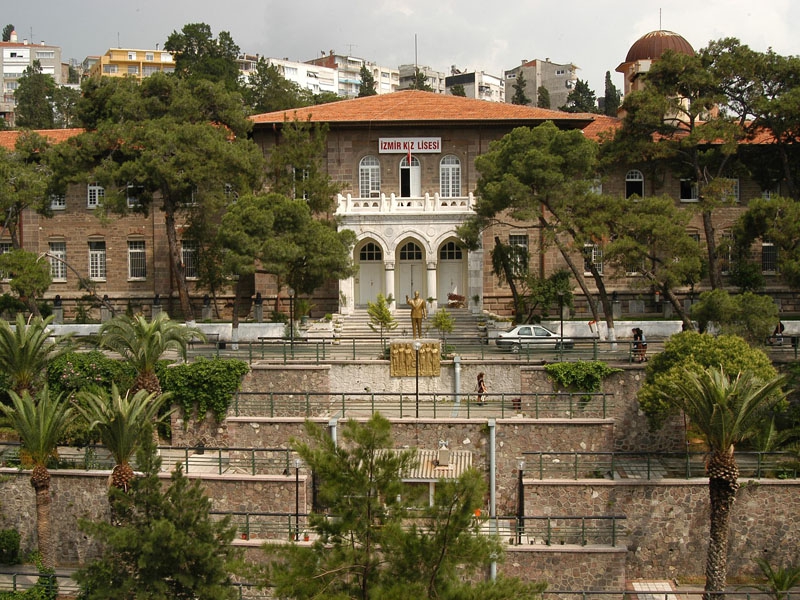The Empire’s Gaze in Planning
I finally got to Kalliope Amygdalou’s session on the Ottoman History Podcast, where she discusses the post-fire urban renewal plans in Thessaloniki and Izmir in the early 20th century. It’s a really wonderful interview focusing on how the French plan-makers for these two cities attempted to make modern Mediterranean cities, and how these plans fed into the French school of city planning used not just in the Mediterranean but in France and French colonies in the far east.
An essay relating to the podcast, and her dissertation, can be found at this link.
There is a lot of fascinating stuff in there, including how insurance companies tried to figure out if the 1917 Thessaloniki fire was an act of war (and thus uninsurable) and the role of public space in the late Ottoman Empire. But I want to focus on one building: today’s İzmir Kız Lisesi, which went through three nation-building plans for three states in about six years.
Izmir Kız Lisesi today, with gold statue of Atatürk out front. Photograph from Ne Nerede, there are many more at that link.
As Amygdalou describes it, the building was first planned by a Young Turk mayor as a “School of Union and Progress,” part of the Young Turk Committee for Union and Progress’ dream of creating a Turkish nation in the Ottoman state. Now, the building is shielded from the coast by mid-century high-rises. But its marble facade and enormous eave would make one think that this is any ordinary late-empire construction like the nearby Milli Kutuphane.
In between that, though, the Greek Monarchy thought about conquering the Turkish coast. Under Aristeidis Stergiadis, Izmir (or Smyrna) was to become the second city of a great Greek empire. In 1919, the Greek authorities took a look at the half-finished hillside school and decided it was to become a new university: the Ionian University of Smyrna.
Sterigiadis. Photograph from OpenArchives.gr
Amygdalou describes this university as a hub of Megali Idea Greece. It was to be open to all ethnic communities: not just Greeks but also Muslims, Jews, Armenians and Slavs. The main education focii were in administration and agriculture. One could learn Arabic, Persian, Armenian languages as well as French, German, Greek and Turkish (Kalliope also said “Hebrew”, and I wonder if it was Hebrew truly or the lingua franca of the Jewish community, Ladino). This was a university to expand commerce and expand the Great Idea.
It was all an idea of Stergiadis, the Greek leader, and Constantin Caratheodory, a mathematician brought in from Germany (where he palled around with Albert Einstein) to helm the new university. Professors were to be brought in from around Europe to teach at this new gem of the Mediterranean.
The architecture of the building changed, according to Amygdalou, but only slightly. It didn’t take much to turn the Ottoman Revival plan into a Byzantine Revival structure: a few windows were given gothic arches, pediments were more pronounced. The Ottoman architectural language was mostly borrowed from Byzantine structures to begin with, and anyways the French Beaux-Arts style gave a contemporary ornamentation.
Ionian University upon completion. Photograph from Wikipedia of unknown source.
None of this was ever to be. Just three years after the Greek Kingdom’s flag was raised over Izmir, the city was occupied/liberated by the Turkish republican army. Smyrna was Izmir again (after a vicious fire burned much of the city), and an imperial university didn’t fit into Republican ideals. A girl’s school – the kız lisesi – spoke more to Atatürk’s vision of women’s liberation along Turkish lines.
There is a great line in the Podcast that I’m going to be forced to paraphrase, where Amygdalou says that this, the early 20th century in the eastern Mediterranean, is a time and place marked by ethnic cleansing and mass destruction. But in the minds of a few people, living in the middle of this, another world was possible. The Ionian University was a place of concord and learning amidst this violence.
That is not to say that we’re talking about a Wes Anderson wonderland. The university was an elite and imperial project. The Megali Idea failed and the Greek Monarchy would be abolished (albeit briefly!) in 1924. The optimism of Sterigiadis and Caratheodory was not well-placed. They were shipping in furniture after the Turkish army had broken the Greek lines.
But there is something charming about this idea of a relatively open university operating in an Izmir untouched by fire. A city that could have become primary in the world, shipping out figs and silk and rebetiko singers. I suppose that every city could have been great. It’s a strange sort of nostalgia to think about the failed future of Izmir, and how great that city could have been.


